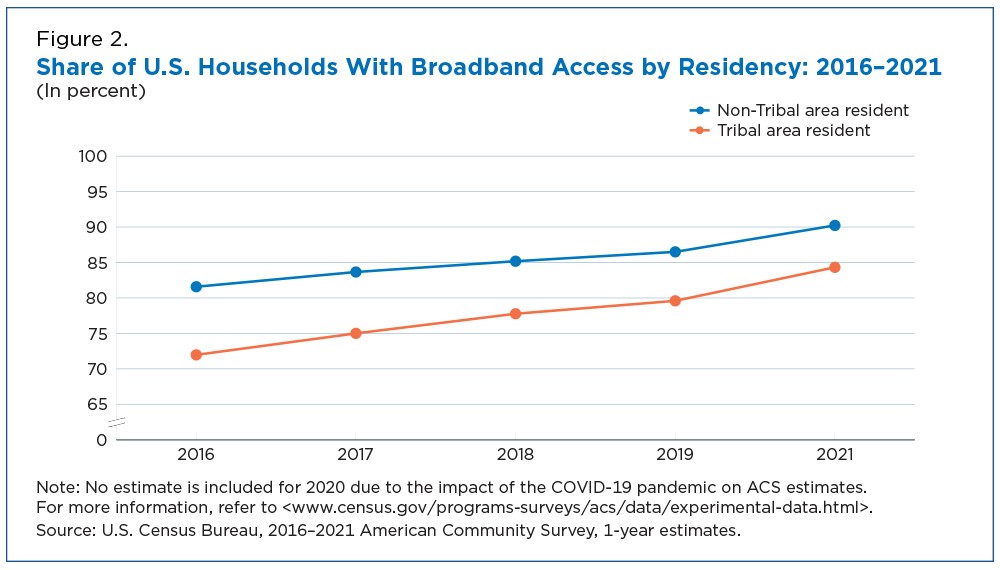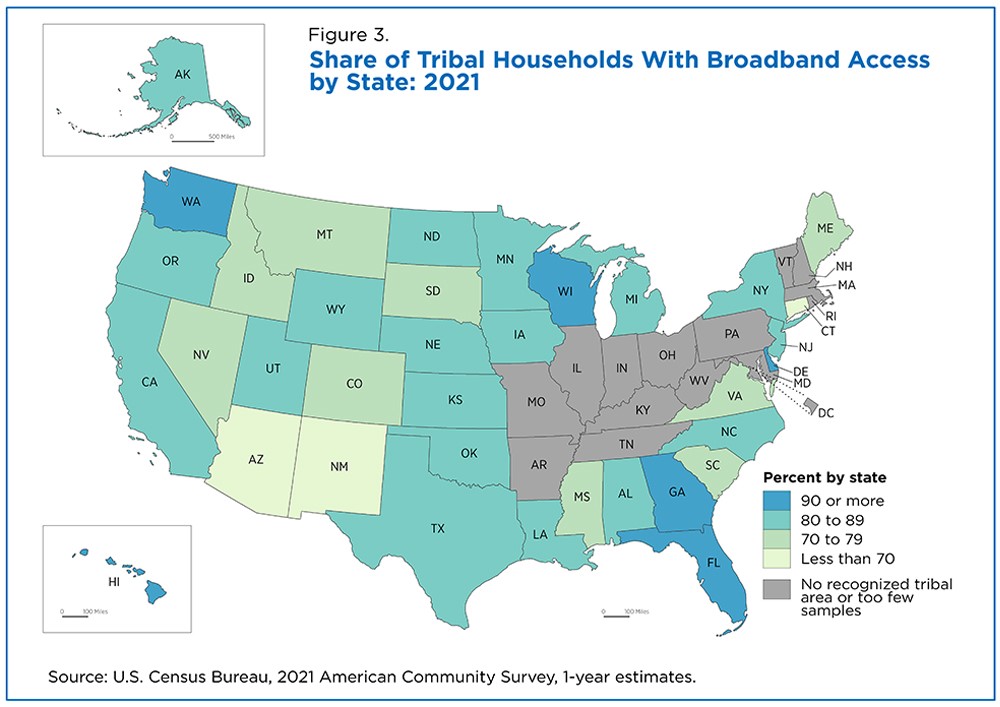American Indian and Alaska Natives in Tribal Areas Have Among Lowest Rates of High-Speed Internet Access
American Indian and Alaska Natives living in tribal areas have among the nation’s lowest rates of high-speed internet access in the United States.
The Computer and Internet Use in the United States: 2021 report released today highlights key estimates of computer ownership and broadband access across the country, including, for the first time, in tribal areas (Figure 1).
From 2016 to 2021, the digital divide between tribal and nontribal households decreased from a gap of 10 percentage points to 6 points.
In this article, a tribal household is defined as any household residing in an American Indian and Alaska Native Area. [PDF <1.0 MB]
Compared to the national average of 90% in 2021, 84% of American Indian and Alaska Native households and 71% of American Indian and Alaska Native households on tribal land had broadband access, according to the American Community Survey (ACS) 1-year estimates.
The “digital divide” is commonly defined as the gap between households with high-speed (broadband) internet access and those without. Research indicates those most affected by this divide or least likely to have internet access are people with disabilities, those 65 years and over, and those living in rural areas, among others.
And some of those factors may play a role in tribal areas’ internet access. For example, 45% of tribal households were in rural areas compared to 19% of nontribal households, and rural tribal households had a lower share (80%) of broadband subscriptions than urban tribal households (88%).
In comparison, the urban-rural connectivity gap was smaller between rural (87%) and urban (91%) households in nontribal areas.
Is the Gap Narrowing?
From 2016 to 2021, the digital divide between tribal and nontribal households decreased from a gap of 10 percentage points to 6 points (Figure 2).
Closing the gap is important given the internet’s growing role in daily personal and professional tasks, such as virtual instruction and health visits, banking, sharing culture and stories, and connecting with family and friends.
Tribal Broadband by State
Not all tribal households experienced unequal access to broadband internet (Figure 3).
Tribal residents in six states (Delaware, Florida, Georgia, Hawaii, Washington and Wisconsin) reported broadband rates at or above the national average of 90% in 2021.
Tribal residents in three states (Arizona, Connecticut, and New Mexico) had among the nation’s lowest rates — less than 70% in Arizona and New Mexico. Connecticut’s tribal broadband rate (60%) was not significantly less than 70%.
More than a quarter (27%) of American Indian and Alaska Native households were in states with the lowest tribal broadband rates while only 4% were in states with the highest tribal broadband.
Notably, the Navajo Reservation and Off-Reservation Trust Land — which spans parts of Arizona, New Mexico, and Utah and has one of the largest tribal American Indian and Alaska Native populations (161,386 residents) in the United States — had a broadband subscription rate of only 33%, according to the 2017-2021 ACS 5-year estimates.
In comparison, the statewide broadband rate was 88% in Arizona; 80% in New Mexico; and 91% in Utah.
My Tribal Area provides more information on broadband subscription rates by specific tribal area.
About the Data
The analysis defines “tribal areas” as all American Indian and Alaska Native Areas [PDF <1.0 MB], according to the American Community Survey (ACS). They include Hawaiian homelands, Alaska Native village statistical areas, and American Indian reservations and rancherias.
Broadband here refers to survey respondents who answered “Yes” to having at least one of the following types of internet subscription: cable; fiber optic or DSL (digital subscriber line); a cellular data plan; satellite; a fixed wireless subscription; or other non-dial-up subscriptions.
Further information on ACS resources for American Indian and Alaska Native populations is available.
Related Statistics
-
National Telecommunications and Information AdministrationThe CRE team is working with NTIA to gather and analyze federal data to identify underserved populations in each State.
-
American Community Survey (ACS)The American Community Survey is the premier source for information about America's changing population, housing and workforce.
-
Intergovernmental Affairs: Tribal AffairsThe Tribal Resource (AIAN) website highlights the Census Bureau's relationship with tribal governments and provides important AIAN and tribal resources.
-
America Counts StoryAmerica Counts: Stories About American Indians and Alaska Natives
Subscribe
Our email newsletter is sent out on the day we publish a story. Get an alert directly in your inbox to read, share and blog about our newest stories.
Contact our Public Information Office for media inquiries or interviews.
-
PopulationMapping Digital Equity in Every StateMay 13, 2022The new Digital Equity Act Population Viewer will help meet the funding goals of the Digital Equity Act of 2021.
-
Computer and Internet UseMapping Impacts of Federal Broadband Investments on Local CommunitiesFebruary 28, 2023New ACCESS BROADBAND Dashboard helps users assess broadband availability and adoption and evaluate how it impacts their local economies.
-
Population2020 Island Areas Censuses: Computer and Internet UseOctober 20, 2022New data from the Island Areas Censuses provide an updated look at estimates of computer ownership and broadband internet subscriptions.
-
NAICS Sector 31-33 ManufacturingSome Less Populous States Have High Manufacturing Revenue Per CapitaSeptember 29, 2025Today is the start of a week of celebrations at the Census Bureau marking the 14th annual Manufacturing Day on October 3.
-
Families and Living ArrangementsCouples’ Finances: Married but SeparateSeptember 24, 2025While most married couples had joint bank accounts, fewer shared all their financial accounts.
-
FertilityChildlessness on the Rise — Except for Women Ages 45 to 50September 23, 2025From 2014 to 2024, the share of older mothers rose as fewer teens and women in their 20s and 30s had children.
-
Business and EconomyHow AI and Other Technology Impacted Businesses and WorkersSeptember 17, 2025Businesses report that, in most cases, adoption of new technologies like robotics and Artificial Intelligence had no impact on worker numbers or skill level.







